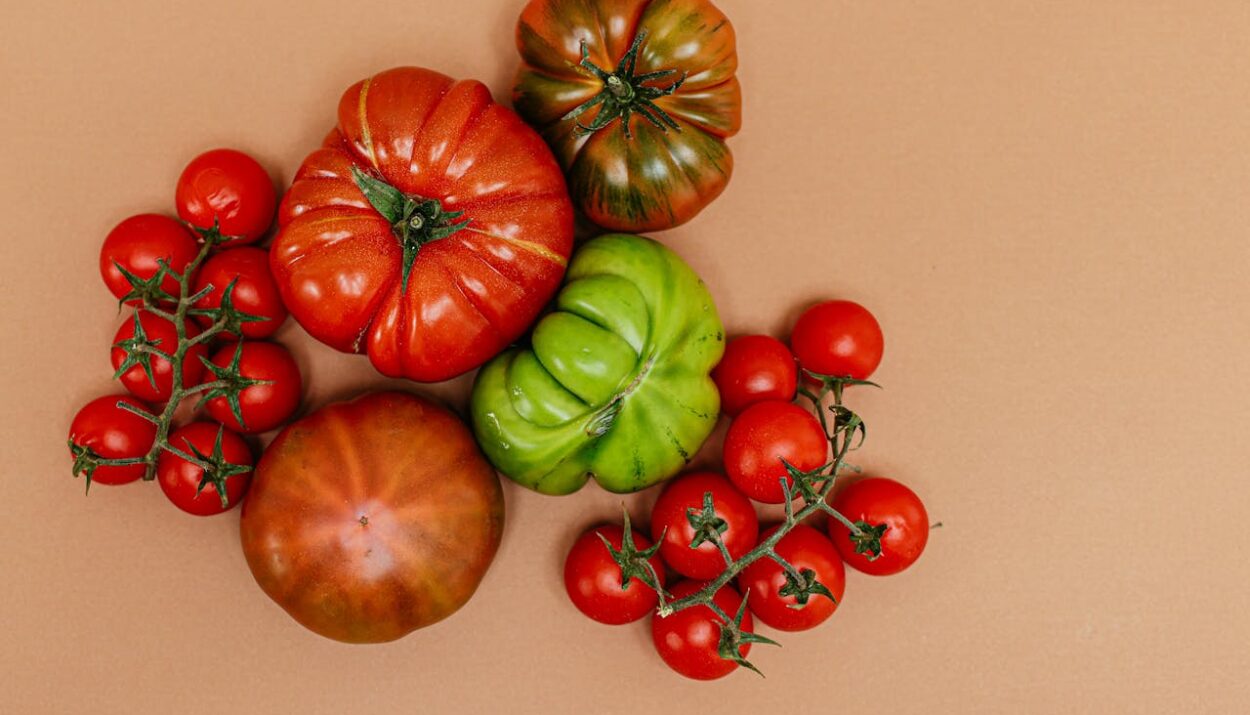Can you eat wrinkled tomatoes? This question often arises when faced with a basket of slightly shriveled produce. This guide explores the truth behind wrinkled tomatoes and whether they’re safe to eat. From understanding the causes of tomato wrinkling to identifying signs of spoilage, we’ll delve into everything you need to know.
Can you eat wrinkled tomatoes? Learn if they’re safe to eat, their nutritional value, potential risks, and practical tips!
In this article:
- Why Do Tomatoes Wrinkle?
- Can You Eat Wrinkled Tomatoes: Safety Considerations
- Ways to Use Wrinkled Tomatoes
- Can You Eat Wrinkled Tomatoes: Nutritional Value
WHY DO TOMATOES WRINKLE?
Tomatoes are known for their vibrant colors and smooth, firm texture when fresh. However, as they ripen, they undergo various physiological changes that can lead to wrinkling.
One of the primary reasons tomatoes wrinkle is due to moisture loss. As the tomato ripens, it gradually loses moisture through transpiration, a process in which water vapor escapes through tiny pores in the tomato’s skin. As moisture evaporates from the tomato, its skin begins to shrink and wrinkle, resulting in the characteristic appearance of wrinkled tomatoes. This moisture loss also contributes to a more concentrated flavor as the sugars and other flavor compounds become more intense in the remaining flesh.
Environmental variables like temperature and humidity can also influence the speed at which tomatoes develop wrinkles. Exposure to high temperatures or prolonged storage in dry conditions can accelerate moisture loss and lead to faster wrinkling.
Despite their wrinkled appearance, are they safe to use in cooking? Can you eat wrinkled tomatoes? Find out in the following.
CAN YOU EAT WRINKLED TOMATOES: SAFETY CONSIDERATIONS
Many consumers are concerned about the safety of eating wrinkled tomatoes. While the wrinkled appearance may raise doubts about their freshness, wrinkled tomatoes are generally safe to eat if they haven’t developed signs of spoilage, such as mold or unusual odors.
One crucial factor to consider is the difference between ripeness and spoilage signs. While wrinkling may indicate that a tomato is past its prime, it doesn’t necessarily mean it’s unsafe to eat. Some degree of wrinkling is a natural part of the ripening process for tomatoes, as they lose moisture and become softer.
However, before consuming wrinkled tomatoes, it’s important to scrutinize them. Look for any signs of mold growth, which can appear as fuzzy patches or discoloration on the surface of the tomato. Mold can produce toxins that may cause illness if ingested, so it’s crucial to discard any tomatoes that show signs of mold.
Additionally, pay attention to the tomato’s texture and smell. If the tomato feels excessively soft or emits an off-putting odor, it may indicate spoilage and warrants discarding.
If wrinkled tomatoes are still in good condition and free from signs of spoilage, you can safely consume them. Many people find wrinkled tomatoes have a more intense flavor than fresh ones, making them suitable for use in sauces, soups, and other cooked dishes where the texture is less important.
So, while wrinkled tomatoes may not look as appealing as their fresh counterparts, you can still enjoy them safely with proper inspection and preparation.
WAYS TO USE WRINKLED TOMATOES
While wrinkled tomatoes may not be as visually appealing as their fresh counterparts, they can still be utilized in various delicious dishes, reducing food waste and maximizing flavor. Here are several creative ways to make the most of wrinkled tomatoes:
- Sauces and Soups: Wrinkled tomatoes are ideal for creating rich and flavorful sauces and soups. Simmer them with garlic, onions, and herbs to make a classic marinara sauce, or blend them into a creamy tomato soup for a comforting meal.
- Salsas and Dips: Chop up wrinkled tomatoes and combine them with onions, peppers, cilantro, and lime juice to make a vibrant salsa. You can also puree them with avocado and spices to create a flavorful dip for vegetable snacks.
- Roasted Tomatoes: Roasting wrinkled tomatoes intensifies their flavor and brings out their natural sweetness. Toss them with olive oil, herbs, and garlic, then roast them in the oven until they’re caramelized and tender. Serve them as a side dish, or use them to top pizzas, salads, or sandwiches.
- Tomato Jam: Turn wrinkled tomatoes into a delicious sweet and savory jam. Cook them down with sugar, vinegar, and spices until thick and spreadable. Tomato jam is ideal for spreading on toast, sandwiches, or cheese boards.
- Preserving: If you have an excess of wrinkled tomatoes, consider storing them for later enjoyment. You can preserve them by canning them in jars, freezing them for long-term storage, or drying them to make sun-dried tomatoes. Preserved tomatoes can be used in various dishes throughout the year, adding more flavor to your meals.
Be creative in the kitchen and transform wrinkled tomatoes into a wide range of tasty dishes, ensuring that they don’t go to waste and that you get the most out of their flavor!
CAN YOU EAT WRINKLED TOMATOES: NUTRITIONAL VALUE
Despite many wondering if wrinkled tomatoes are safe to eat, they retain their nutritional value. That means they can be an excellent addition to your diet. The texture and taste may change as tomatoes ripen and wrinkle, but their nutrient content remains relatively stable.
Tomatoes contain essential vitamins and minerals, making them a nutritious choice for meals and snacks. They are exceptionally high in vitamin C, necessary for our immunity, collagen production, and wound healing. Additionally, tomatoes are a fantastic source of vitamin A, potassium, and folate, essential for overall health and well-being.
Lycopene, an antioxidant responsible for tomatoes’ red color, is a significant nutrient in tomatoes. Researchers have linked lycopene to many health benefits, like reduced risk of cardiovascular disease and specific types of cancer.
As tomatoes ripen and wrinkle, their lycopene content may increase, potentially providing even more antioxidant benefits. However, it’s essential to note that cooking tomatoes can also enhance the bioavailability of lycopene, making cooked tomato products such as sauces and soups wealthy sources of this beneficial compound.
In addition to vitamins and antioxidants, tomatoes are low in calories and contain no fat, making them an excellent choice for those looking to maintain or lose weight. They are also high in water and fiber, which can help you feel full and satisfied while supporting digestive health.
So, wrinkled tomatoes may not look as appealing as their fresh counterparts, but they still offer many nutritional benefits.
_____
Can you eat wrinkled tomatoes? With the proper knowledge and precautions, you can confidently enjoy their unique flavor and reap their health benefits without hesitation. Happy cooking!
This post may contain affiliate links. You can read the affiliate disclosure here.








